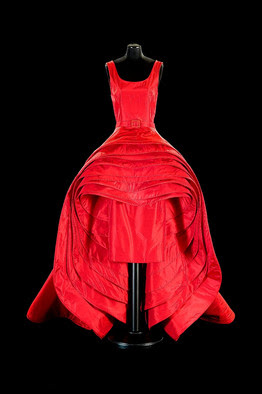Known for wild sculptural gowns and voluminous dresses of pleated silk, Italy's Roberto Capucci will soon be the latest fashion designer to get the major-museum treatment.
"Art Into Fashion," at the Philadelphia Museum of Art from March 16 to June 5, celebrates a designer who—though not a household name in America—was a major figure of the couture scene from the 1950s to the 1980s.
Mr. Capucci was well-positioned to dress the Italian elite: He sold his first design (at age 18, in the late 1940s) to Marcella de Marchis Rossellini, then the wife of famed film director Roberto Rossellini. Mr. Capucci made a splash at Italy's 1951 fashion show.
By 1962, Life Magazine was hailing Mr. Capucci as one of two rising couture stars—the other being Yves Saint Laurent.
With a reputation for spectacular innovation in shape, Mr. Capucci employed unusual materials, such as pebbles, raffia, plastic and even glow-in-the-dark beads. "His dresses became sculptures almost from the beginning," said curator Dilys Blum.
Mr. Capucci's dresses were worn by Gloria Swanson and Marilyn Monroe, but his work wasn't only for the famous. "As he focused more on fashion as art, he was primarily known for dressing aristocratic Italian ladies," said Valerie Steele, director and chief curator of the Museum at the Fashion Institute of Technology.
The Philadelphia exhibit includes more than 80 works, notably Mr. Capucci's 1956 "Nove Gonne" ("Nine Skirts"), which pairs a simple bodice with nine overlapping layers of skirts in red silk taffeta. The seductive dress made an appearance in an advertisement for the 1957 Cadillac Series 62 convertible, featuring an elegant model posing in the Roman Forum.
Mr. Capucci's use of tiny, delicate pleating took shapes into fanciful territory: A gown of gold silk lamé suggests angel wings; another in red silk mimics the curves of hot flames.
When he returned to Italy in 1968 after a sojourn in Paris, he continued to emphasize artistic vision over commercial concerns. And in 1980, Mr. Capucci resigned from the rigors of the couture schedule entirely. "I was exasperated, I'd had enough of rules and calendars," he said in a 1996 exhibition catalog. "If a painter or sculptor hasn't finished, he doesn't show."
Mr. Capucci's focus shifted to fashion-as-sculpture, and the designs grew ever more spectacular; in 1995, he was invited to show at the Venice Biennale art show.
Today, the museum world continues its ever-closer embrace of fashion designer clothes. Later this year, the Dallas Museum of Art will stage a retrospective for French couturier Jean-Paul Gaultier. A recent donation to New York's Metropolitan Museum of Art's Costume Institute will renovate the fashion galleries, allowing for more exhibitions.
Source: The Wall Street Journal

No comments:
Post a Comment